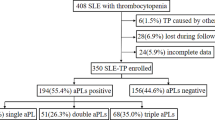Abstract
Adult idiopathic thrombocytopenic purpura (ITP) is an acquired autoimmune disease that may be associated with other autoimmune disorders and a positive antinuclear antibody (ANA). This pilot study aimed to determine the clinical significance of a positive ANA test on the presentation and response to steroids. The medical records of 46 patients aged 15 years or older who were diagnosed with ITP at King Abdullah University Hospital from January, 2004 to December, 2006 were retrospectively analyzed. ANA results were available for 41 patients, and only 10 patients had a positive test. The study showed no association between the ANA and any of the patients’ characteristics at presentation. This included the age, sex, presence of autoimmune diseases, a family history of autoimmune diseases, platelet count, hemoglobin level, and erythrocyte sedimentation rate (ESR). It is interesting to note that the mean platelet count after 2 weeks of steroids was 99,323 per cu/ml in patients with a negative ANA, and 32,800 per cu/ml in those with a positive ANA (P = 0.006). The difference in mean platelet count between positive and negative ANA-tested patients remained significant after adjusting for sex, age, and ESR (P = 0.001). Also, patients with a positive ANA were 6.25 times more likely of not achieving a complete response defined as a platelet count of 100,000 per cu/ml or more for a minimum of 3 months after discontinuation of therapy. In conclusion, the ANA test could be a useful screening test that predicts initial response to steroid therapy. Patients who test positive are expected to have lower response and should be monitored closely.
Similar content being viewed by others
References
Yang R, Han ZC (2002) Pathogenesis and management of chronic immune thrombocytopenic purpura: an update. Int J Hematol 71:18–24
McMillan R, Imbach P (2003) Immune thrombocytopenic purpura. In: Loscalzo J, Schafer AI (eds) Thrombosis and Hemorrhage. Lippincott Williams & Wilkins, Philadelphia, pp 476–495
George JN, Woolf SH, Raskob GE et al (1997) Diagnosis and treatment of idiopathic thrombocytopenic purpura: recommendations of the American society of Hematology. Ann Int Med 126:319–26
George JN, Woolf SH, Raskob GE et al (1996) Idiopathic thrombocytopenic purpura: a practice guideline developed by explicit methods for the American society of Hematology. Blood 88:33–40
Chudwin DS, Ammann AJ, Cowan MJ et al (1983) Significance of a positive antinuclear antibody test in a pediatric population. Am J Dis Child 137:1103–6
Nakamura RM, Bylund DJ (1994) Contemporary concepts for the clinical and laboratory evaluation of systemic lupus erythematosus and “lupus-like” syndrome. J Clin Lab Anal 8:347–59
Allen RC, Dewez P, Stuart L et al (1991) Antinuclear antibodies using HEp-2 cells in normal children and in children with common infections. J Paediatr Child Health 27:39–42
Cabral DA, Petty RE, Fung M et al (1992) Persistent antinuclear antibodies in children without identifiable inflammatory rheumatic or autoimmune disease. Pediatrics 89:441–4
Zimmerman S, Ware R (1997) Clinical significance of the antinuclear antibody test in selected children with idiopathic thrombocytopenic purpura. J Pediatr Hematol Oncol 19(4):297–303
Li H, Zhan G, Zhao H et al (2005) Chronic idiopathic thrombocytopenic purpura in adult Chinese patients: a retrospective single-centered analysis of 1791 cases. Chin Med J 118(1):34–37
Rabinowitz Y, Dameshek W (1960) Systemic lupus erythematosus after “idiopathic” thrombocytopenic purpura: a review. A study of systemic lupus erythematosus occurring after 78 splenectomies for “idiopathic” thrombocytopenic purpura, with a review of the pertinent literature. Ann Intern Med 52:1–15
Breckenridge RT, Moore RD, Ratnoff OD (1967) A study of thrombocytopenia. New histologic criteria for the differentiation of idiopathic thrombocytopenia and thrombocytopenia associated with disseminated lupus erythematosus. Blood 30:39–53
Anderson MJ, Peebles CL, McMillan R et al (1985) Fluorescent antinuclear antibodies and anti-SS-A/Ro in patients with immune thrombocytopenia subsequently developing systemic lupus erythematosus. Ann Intern Med 103:548–50
Perez HD, Kutler E, Embury S (1985) Idiopathic thrombocytopenic purpura with high titer, speckled pattern antinuclear antibodies; possible marker for systemic lupus erythematosus. Arthritis Rheum 28:596–7
Panzer S, Penner E, Graninger W et al (1989) Antinuclear antibodies in patients with chronic idiopathic autoimmune thrombocytopenia followed 2–30 years. Am J Hematol 32:100–3
Author information
Authors and Affiliations
Corresponding author
Rights and permissions
About this article
Cite this article
Abbasi, S.Y., Milhem, M. & Zaru, L. A positive antinuclear antibody test predicts for a poor response to initial steroid therapy in adults with idiopathic thrombocytopenic purpura. Ann Hematol 87, 459–462 (2008). https://doi.org/10.1007/s00277-008-0448-1
Received:
Accepted:
Published:
Issue Date:
DOI: https://doi.org/10.1007/s00277-008-0448-1



